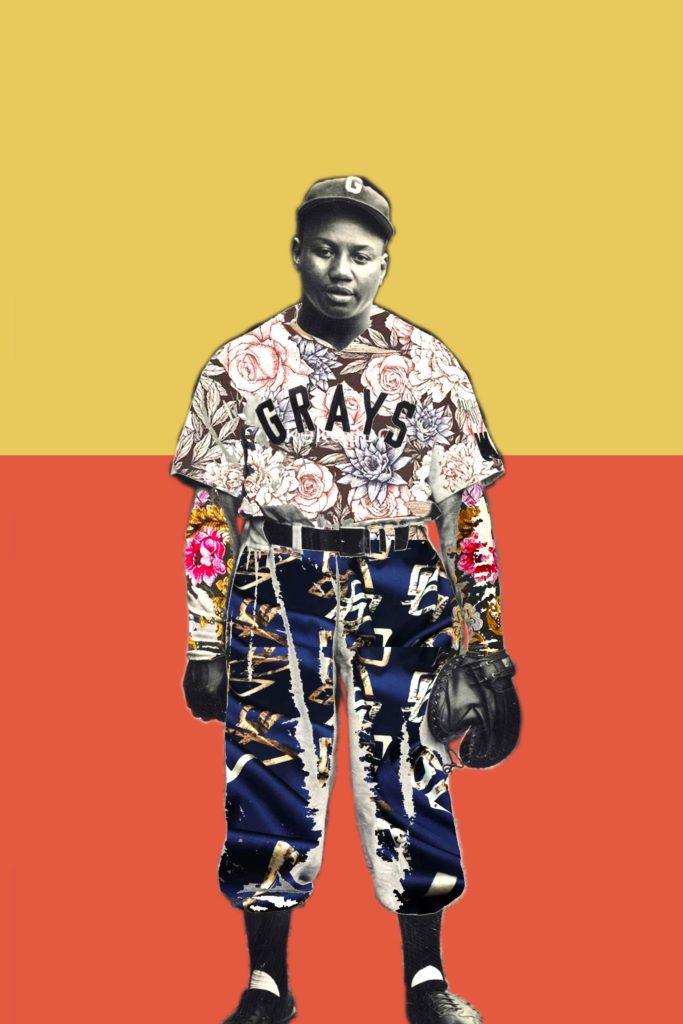Josh Gibson – Downtown Renown
One of the Greatest Home Run Hitters in Baseball History Represented the Homestead Grays and Pittsburgh Crawfords
Josh Gibson, baseball player and home run legend, is one of 14 highlighted Pittsburgh athletes as part of the Downtown Renown: Pittsburgh Sports Greats series showcasing stories as inspirational as they are amazing. Designed in collaboration with artist Gavin Benjamin, find all sports profiles windows currently on view in windows around the neighborhood.
A resident of Pittsburgh’s North Side from the age of 10 and catcher for the Pittsburgh Crawfords and Homestead Grays, Josh Gibson became one of the greatest home run hitters in baseball history, as well as an excellent contact hitter. One of the estimated 962 home runs during his 17-year career landed 580 feet away from home plate at Yankee Stadium. Gibson led the Grays to nine consecutive Negro National League pennants and batted .426 in exhibition games against Major League pitching. Satchel Paige, his onetime Crawfords’ teammate, and rival proclaimed, “He was the greatest hitter who ever lived.”
Born in Georgia, Gibson migrated north with his family to join his father who had found work in a Carnegie-Illinois steel mill. The family settled on the North Side, but Josh’s skill soon took him to ball fields and parks far from home. His size and strength made him a threat both at the plate and behind it. Gibson played some of his earliest baseball in the industrial leagues, competing for the Westinghouse Air Brake employee team. During the summer of 1930, Gibson played for several Westinghouse Company teams while traveling throughout the tri-state area.
Legendary Achievements
Gibson’s achievements at the plate with the Homestead Grays and Pittsburgh Crawfords are legendary. As an 18-year old in Yankee Stadium, he slammed a home run into the left field bullpen that travelled more than 500 feet. For years fans claimed it as one of the longest drives ever hit in that ballpark. In his 15 seasons in the Negro National League (1931-1946) he was named to nine East-West All-Star squads, scored 594 runs, had 521 RBI’s, and a .387 batting average. He is credited with having been the Negro National League batting champion in 1936-38-42-45. His success and personality paired him with Satchel Paige as the best-known Negro League players.
In addition to playing in the Negro Leagues, Josh barnstormed against major league competition and like more than 150 African American players in the late 1930s and 1940s, he played in Mexico, Puerto Rico, the Dominican Republic, and Cuba mostly in winter league play. Gibson excelled in the Mexican Baseball League. While playing for only a quarter of the 1940 season for Azules (which translates to “Blues”) de Veracruz, the slugger still tied for the league lead in home runs with 11. The following year he claimed the title with 33 in 94 games, exceeding his runner up by 14 home runs. Gibson also played winter ball for the Cangrejeros de Santurce and the Dragones de Ciudad Trujillo in Puerto Rico, and the Leopardes de Santa Clara in Cuba. Outside of the United States, African American star players often benefitted from higher salaries and instead of facing discrimination, they were revered on the ballfield and off.
Tragically, the slugger developed a brain tumor and died of a stroke on January 20, 1947 a few months before Jackie Robinson broke the color line with the Brooklyn Dodgers. Inducted into the National Baseball Hall of Fame in 1972, Gibson became the second Negro League player, after Paige, to be so honored. He was also inducted posthumously to the Mexican Baseball Hall of Fame in 1974.
Learn more about the history of Negro League Baseball in Pittsburgh from the Western Pennsylvania Sports Museum at the Heinz History Center.
This spotlight is a part of the Downtown Renown: Pittsburgh Sports Greats series. Learn more about the project, and look for all 14 sports profile windows in Downtown!

Explore all the featured athletes
Arnold Palmer • Bill Mazeroski • Charles “Chuck” Cooper • Dan McCoy • Franco Harris • Honus Wagner • Joe Greene • John Woodruff • Josh Gibson • Mario Lemieux • Roberto Clemente • Suzie McConnell-Serio • Swin Cash • Sidney Crosby

by Gavin Benjamin
📍 View this Pittsburgh Sports Great window installation at Oliver Building, 537 Smithfield Street, Downtown Pittsburgh.

